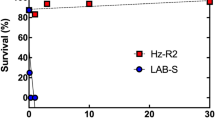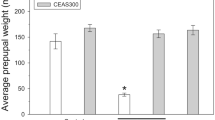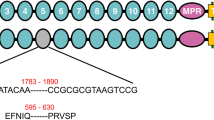Abstract
Preventing insect pests from developing resistance to Bacillus thuringiensis (Bt) toxins produced by transgenic crops is a major challenge for agriculture. Theoretical models suggest that plants containing two dissimilar Bt toxin genes ('pyramided' plants) have the potential to delay resistance more effectively than single-toxin plants used sequentially or in mosaics. To test these predictions, we developed a unique model system consisting of Bt transgenic broccoli plants and the diamondback moth, Plutella xylostella. We conducted a greenhouse study using an artificial population of diamondback moths carrying genes for resistance to the Bt toxins Cry1Ac and Cry1C at frequencies of about 0.10 and 0.20, respectively. After 24 generations of selection, resistance to pyramided two-gene plants was significantly delayed as compared with resistance to single-gene plants deployed in mosaics, and to Cry1Ac toxin when it was the first used in a sequence. These results have important implications for the development and regulation of transgenic insecticidal plants.
This is a preview of subscription content, access via your institution
Access options
Subscribe to this journal
Receive 12 print issues and online access
$209.00 per year
only $17.42 per issue
Buy this article
- Purchase on Springer Link
- Instant access to full article PDF
Prices may be subject to local taxes which are calculated during checkout

Similar content being viewed by others
References
Roush, R.T. & Shelton, A.M. Assessing the odds: the emergence of resistance to Bt transgenic plants. Nat. Biotechnol. 15, 816–817 (1997).
James, C. Global Status of Commercialized Transgenic Crops: 2002 (brief no. 27) (International Service for the Acquisition of Agri-biotech Applications, Ithaca, New York, USA, 2002).
Shelton, A.M., Zhao, J.-Z. & Roush, R.T. Economic, ecological, food safety, and social consequences of the deployment of Bt transgenic plants. Annu. Rev. Entomol. 47, 845–881 (2002).
Carrière, Y. et al. Long-term regional suppression of pink bollworm by Bacillus thuringiensis cotton. Proc. Natl. Acad. Sci. USA 100, 1519–1523 (2003).
Gould, F. Sustainability of transgenic insecticidal cultivars: integrating pest genetics and ecology. Ann. Rev. Entomol. 43, 701–726 (1998).
Roush, R.T. Bt-transgenic crops: just another pretty insecticide or a chance for a new start in resistance management? Pesticide Sci. 51, 328–334 (1997).
Roush, R.T. Two-toxin strategies for management of insect resistant transgenic crops: can pyramiding succeed where pesticide mixtures have not? Phil. Trans. Proc. R. Soc. London Ser. B 353, 1777–1786 (1998).
Shelton, A.M., Tang, J.D., Roush, R.T., Metz, T.D. & Earle, E.D. Field tests on managing resistance to Bt-engineered plants. Nat. Biotechnol. 18, 339–342 (2000).
US Environmental Protection Agency. Biopesticides registration action document for Bacillus thuringiensis plant-incorporated protectants (USEPA, Washington, DC, USA, 16 October 2001). http://www.epa.gov/pesticides/biopesticides/pips/bt_brad.htm
Office of the Gene Technology Regulator, Australian Department of Health and Ageing. Record of GMO and GM Product Dealings under Section 138 of the Gene Technology Act 2000 (DIR-012). (Office of the Gene Technology Regulator, Canberra, Australia, 22 September 2002). http://www.ogtr.gov.au/rtf/gmorec/dirtable.rtf
US Environmental Protection Agency. Biopesticide active ingredient fact sheet: Bacillus thuringiensis Cry2Ab2 protein and the genetic material necessary for its production in cotton. OPP Chemical Code 006487. (USEPA, Washington, DC, USA, 23 December 2002). http://www.epa.gov/oppbppd1/biopesticides/ingredients/factsheets/factsheet_006487.htm
Tabashnik, B.E. et al. Control of resistant pink bollworm (Pectinophora gossypiella) by transgenic cotton that produces Bacillus thuringiensis toxin Cry2Ab. Appl. Environ. Microbiol. 68, 3790–3794 (2002).
Roush, R.T. & Daly, J.C. The role of population genetics in resistance research and management. in Pesticide Resistance in Arthropods (eds. Roush, R.T. & Tabashnik, B.E.) 97–152 (Chapman and Hall, New York, 1990).
Heckel, D.G., Gahan, L.J., Liu, Y.B. & Tabashnik, B.E. Genetic mapping of resistance to Bacillus thuringiensis toxins in diamondback moth using biphasic linkage analysis. Proc. Natl. Acad. Sci. USA 96, 8373–8377 (1999).
Tabashnik, B.E., Liu, Y.-B., Finson, N., Masson, L. & Heckel, D.G. One gene in diamondback moth confers resistance to four Bacillus thuringiensis toxins. Proc. Natl. Acad. Sci. USA 94, 1640–1644 (1997).
Zhao, J.-Z. et al. Development and characterization of diamondback moth resistance to transgenic broccoli expressing high levels of Cry1C. Appl. Environ. Microbiol. 66, 3784–3789 (2000).
Zhao, J.-Z., Li, Y.X., Collins, H.L. & Shelton, A.M. Examination of the F2 screen for rare resistance alleles to Bacillus thuringiensis toxins in the diamondback moth. J. Econ. Entomol. 95, 14–21 (2002).
Baxter, S., Zhao, J.-Z., Shelton, A.M. & Heckel, D.G. Linkage mapping in a multiresistant strain of diamondback moth Plutella xylostella reveals separate genetic mechanisms of Cry1A and Cry1C resistance. Abstracts of the Fourth International Symposium on Molecular Insect Science. J. Insect Sci. 2 (17), 3 (2002). http://www.bioone.org/bioone/?request=get-document&issn=1536-2442&volume=002&issue=17&page=0001.
Tabashnik, B.E. et al. Insect resistance to transgenic Bacillus thuringiensis crops: lessons from the laboratory and field. J. Econ. Entomol. 96, 1031–1038 (2003).
Zhao J.-Z. et al. Different cross-resistance patterns in the diamondback moth resistant to Bacillus thuringiensis toxin Cry1C. J. Econ. Entomol. 94, 1547–1552 (2001).
Shelton, A.M., Cooley, R.J., Kroening, M.K., Wilsey, W.T. & Eigenbrode, S.D. Comparative analysis of two rearing procedures for diamondback moth. J. Entomol. Sci. 26, 17–26 (1991).
Metz, T.D., Roush, R.T., Tang, J.D., Shelton, A.M. & Earle, E.D. Transgenic broccoli expressing a Bacillus thuringiensis insecticidal crystal protein: implications for pest resistance management strategies. Mol. Breed. 1, 309–317 (1995).
Cao, J., Tang, J.D., Shelton, A.M. & Earle, E.D. Transgenic broccoli with high levels of Bacillus thuringiensis Cry1C protein are resistant to susceptible, cry1A resistant and cry1C resistant diamondback moths. Mol. Breed. 5, 131–141 (1999).
Cao, J., Zhao, J.-Z., Tang, J.D., Shelton, A.M. & Earle, E.D. Broccoli plants with pyramided cry1C and cry1Ac Bt genes control diamondback moths resistant to Cry1A and Cry1C proteins. Theor. Appl. Genet. 105, 258–264 (2002).
Tang, J.D. et al. Greenhouse tests on resistance management of Bt transgenic plants using refuge strategies. J. Econ. Entomol. 94, 240–247 (2001).
Tabashnik, B.E. et al. Inheritance of resistance to Bt toxin Cry1Ac in a field-derived strain of pink bollworm (Lepidoptera: Gelechiidae). J. Econ. Entomol. 95, 1018–1026 (2002).
SAS Institute. SAS User's Guide, Statistics edn. 5 (SAS Institute, Cary, NC, USA, 1985).
Acknowledgements
We thank J. Plate and G. Young for technical assistance and F. Gould for helpful comments on the experimental design. This work was supported by the US Department of Agriculture (NRI 99-35302-7999).
Author information
Authors and Affiliations
Corresponding author
Ethics declarations
Competing interests
The authors declare no competing financial interests.
Rights and permissions
About this article
Cite this article
Zhao, JZ., Cao, J., Li, Y. et al. Transgenic plants expressing two Bacillus thuringiensis toxins delay insect resistance evolution. Nat Biotechnol 21, 1493–1497 (2003). https://doi.org/10.1038/nbt907
Received:
Accepted:
Published:
Issue Date:
DOI: https://doi.org/10.1038/nbt907
This article is cited by
-
The invasive fall armyworm, Spodoptera frugiperda, in Africa and Asia: responding to the food security challenge, with priorities for integrated pest management research
Journal of Plant Diseases and Protection (2023)
-
Ongoing ecological and evolutionary consequences by the presence of transgenes in a wild cotton population
Scientific Reports (2021)
-
Stacked insecticidal genes in potatoes exhibit enhanced toxicity against Colorado potato beetle, Leptinotarsa decemlineata (Coleoptera: Chrysomelidae)
Plant Biotechnology Reports (2021)
-
Transgene Stacking as Effective Tool for Enhanced Disease Resistance in Plants
Molecular Biotechnology (2020)
-
Plastid-expressed Bacillus thuringiensis (Bt) cry3Bb confers high mortality to a leaf eating beetle in poplar
Plant Cell Reports (2020)



